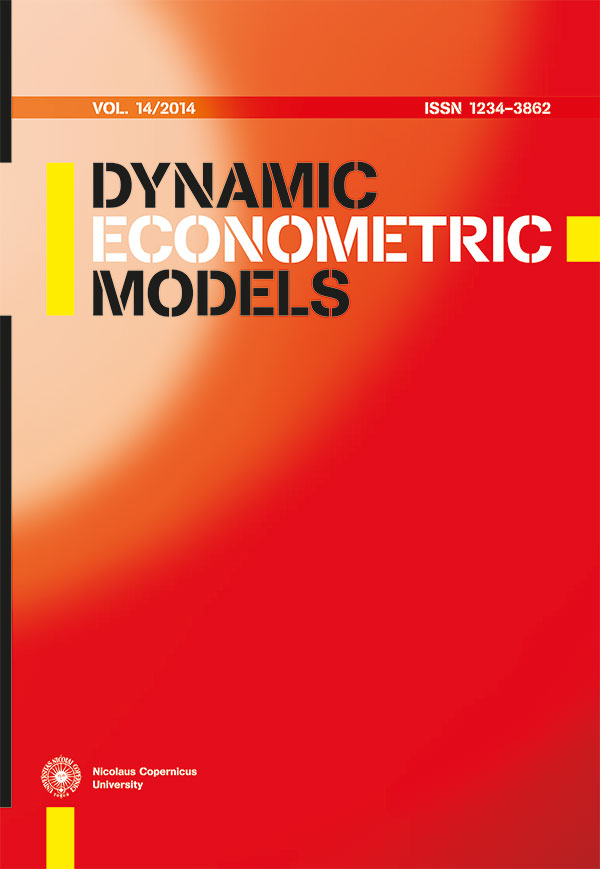Business Cycles Variability in Polish Regions in the Years 2000 – 2016
DOI:
https://doi.org/10.12775/DEM.2017.011Keywords
business cycle, region, variabilityAbstract
The aim of this article is to study the morphology of regional business cycle in Poland. To do this, such parameters were calculated, like: cycle length, coherence ratio, standard deviation ratio, mean delay, cross-correlation ratio. The main conclusion is that regions have different sensitivity to economy "shocks," both positive and negative. The analysis of the regional specialization appear varied level of it among individual regions. Despite a few exceptions, it can be marked correlation between the level of regional specialization and the degree of sensitivity to economic disturbances.
References
Adamowicz, E., Dudek, S., Pachucki, D., Walczyk, K. (2008), Synchronization of The Business Cycle of Polish Economy With The Euro Area Countries in The Context of Structure of These Economies, Publishing IRG SGH, Warsaw.
Anagnostou, A., Panteladis, I., Tsiapa, M. (2015), Disentangling Different Patterns of Business Cycle Synchronicity in The EU Regions, Empirica, 42 (3), 615-641, DOI: http://10.1007/s10663-014-9268-9.
Artis, M., Zhang, W. (1997), International Business Cycles and The ERM: Is There a European Business Cycle?, International Journal of Finance and Economics, 2 (1), 1-16.
Barrios, S., Lucio, J. (2003), Economic Integration and Regional Business Cycles: Evidence From The Iberian Regions, Oxford Bulletin of Economics and Statistics, 65 (4), 497-515.
Carlino, G., Sill, K. (2001), Regional Income Fluctuations. Common Trends and Common Cycles, Review of Economics and Statistics, 83 (3), 446-456.
Correia, L., Gouveia, S. (2013) Business Cycle Synchronization At The Regional Level: Evidence for The Portuguese Regions, Regional and Sectoral Economic Studies, 13-1, 91-108.
Crone, T.M. (2005), An Alternative Definition of Economic Regions in The United States Based on Similiarities in State Business Cycles, The Review of Economics and Sta-tistics, 87 (4), 617-626.
Drozdowicz-Bieć, M. (2012), Cykle i wskaźniki koniunktury (Business Cycles and Indica-tors), Publisher Poltext, Warsaw.
Fatas, A. (1997), EMU: Countries or Regions? Lessons From The EMS Experience, Euro-pean Economic Review, 41 (3-5), 743-751.
Frankel, J., Rose, A. (1996), The Endogeneity of The Optimum Currency Area Criteria, National Bureau Of Economic Research Working Paper, 5700, 1-33, DOI: 10.3386/w5700.
Frenkel, M., Nickel, C. (2002), How Symmetric Are The Shocks Adjustment Dynamics Between The Euro Area and Central and Eastern European Countries? International Monetary Fund, IMF Working Paper, 02/222, 1-27.
Grudkowska, S., Paśnicka, E. (2007), X-12-ARIMA i TRAMO/SEATS – empiryczne porównanie metod wyrównania sezonowego w kontekście długości próby (X–12 – ARIMA and TRAMO/SEATS – Empirical Comparison of Seasonal Alignment Methods in The Context of The Length of The Sample), Polish National Bank, Department of Public Relations, Warsaw.
Krugman, P. (1991), Increasing returns and economic geography, Journal of Political Economy, 99 (3), 483-499.
Krugman, P. (1993), Lessons of Massachusetts for EMU, (in:) Torres, F., Giavazzi, F. (eds.) Adjustment and Growth in the European Monetary Union, CEPR and Cambridge University Press, 241-261.
Marelli, E. (2007), Specialization and Convergence of European Regions, The European Journal of Comparative Economics, 4 (2), 149-178.
McKinnon, R. (2002), Optimum Currency Areas and The European Experience, Econom-ics of Transition, 10 (2), 343-364.
Montoya, L.A., de Haan, J. (2007), Regional Business Cycle Synchronization in Europe?, Bruges European Economic Research Papers, College of Europe, Brugge, Natolin.
Statistical Yearbook of the Regions – Poland, http://stat.gov.pl/obszary-tematyczne/roczniki-statystyczne/roczniki-statystyczne/rocznik-statystyczny-wojewodztw-2015,4,10.html.
www.stat.gov.pl/ Local Data Bank.
Weimann, M. (2003), OCA Theory and EMU Eastern Enlargement - An Empirical Appli-cation, Deutsche Bank Research Working Paper Series, 8, 1-33.
Downloads
Published
How to Cite
Issue
Section
License
The journal provides an Open Access to its content based on the non-exclusive licence Creative Commons (CC BY-ND 4.0).
To enable the publisher to disseminate the author's work to the fullest extent, the author must agrees to the terms and conditions of the License Agreement with Nicolaus Copernicus University.
Stats
Number of views and downloads: 538
Number of citations: 0



